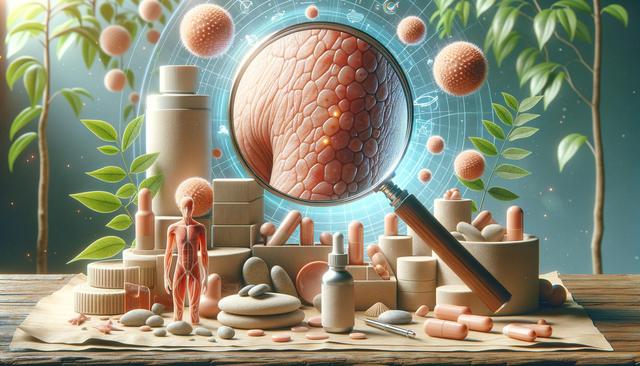Unveiling Prurigo Nodularis: Symptoms and Solutions
Prurigo nodularis, a skin condition that often flies under the radar, can significantly disrupt the quality of life for those affected. Understanding its symptoms and available treatments is crucial for early intervention and effective management.

Recognizing the Symptoms of Prurigo Nodularis
Prurigo nodularis is most commonly characterized by the appearance of hard, itchy nodules that form on the skin, often as a result of chronic scratching or rubbing. These nodules can vary in size and number, and they typically appear on the arms, legs, and other areas that are easy to reach. The intense itch associated with the condition often leads to a cycle of scratching and skin damage, which can make the nodules more pronounced and difficult to treat.
Other common symptoms include:
- Thickened, scaly skin over the nodules
- Hyperpigmentation or darkened patches around affected areas
- Dry, cracked skin that may bleed or become infected
Early recognition of these symptoms is essential for managing the condition effectively. Consulting with a dermatologist or a Prurigo Nodularis Specialist Near Me can help in obtaining a proper diagnosis and initiating an appropriate treatment plan.
Understanding the Causes and Risk Factors
While the exact cause of prurigo nodularis remains unclear, it is often associated with underlying conditions that contribute to chronic itching and skin inflammation. Some of the more common conditions linked to prurigo nodularis include eczema, chronic kidney disease, liver disorders, and certain psychiatric conditions such as anxiety or obsessive-compulsive disorder.
Contributing risk factors may include:
- Long-term skin irritation or scratching
- Immune system dysregulation
- History of atopic dermatitis or other allergic skin conditions
Identifying and managing these underlying health issues can be vital in reducing symptoms. A multi-disciplinary approach involving dermatologists, immunologists, and mental health professionals may offer a more comprehensive path toward relief.
Treatment Options and Conventional Therapies
Treating prurigo nodularis typically involves addressing both the itch and the inflammation while also breaking the itch-scratch cycle. Topical and systemic medications are commonly used to manage symptoms and reduce flare-ups. Among the more widely used treatments are corticosteroids, which can help reduce inflammation and itching. For more persistent nodules, Corticosteroid Injections for Prurigo may be recommended to target specific problem areas.
Common treatment approaches include:
- Topical corticosteroids and antihistamines
- Oral medications like gabapentin or antidepressants to reduce nerve-related itch
- Phototherapy using UV light to calm skin inflammation
In addition, certain topical agents, sometimes found in the Best Creams for Prurigo Nodularis, may also contain ingredients like menthol or pramoxine to offer soothing effects. However, it’s important to note that treatment effectiveness can vary, and what works for one person may not work for another.
Natural and Alternative Remedies
Alongside conventional medical treatments, natural remedies are gaining attention for their potential to support skin health and reduce itching. One such remedy is Aloe Vera for Prurigo Nodularis, which is known for its soothing and anti-inflammatory properties. Applying aloe vera gel to affected areas may help calm irritated skin and reduce the urge to scratch.
Other natural approaches worth considering include:
- Oatmeal baths for moisturizing and soothing the skin
- Coconut oil for hydration and mild anti-inflammatory effects
- Chamomile or calendula creams for calming inflamed skin
While these treatments may not replace medical therapies, they can complement them and offer additional Itchy Skin Nodules Relief. As always, it is advisable to consult with a healthcare provider before starting any new treatment regimen, especially when combining natural and prescription therapies.
Emerging Treatments and Future Outlook
Research into prurigo nodularis has accelerated in recent years, leading to promising advancements in treatment. Innovations in immunotherapy and biologics are showing encouraging results in clinical trials, targeting specific pathways that contribute to chronic itch and inflammation. Some of the New Treatments for Prurigo Nodularis 2025 are expected to include novel biologic agents that block itch-inducing cytokines, offering a more targeted and potentially effective approach.
In addition to pharmaceuticals, technology-driven tools such as wearable devices that monitor scratching behavior or deliver therapeutic light therapy are also being explored. These innovations aim to provide more personalized and sustainable treatment options for individuals with chronic skin conditions like prurigo nodularis.
As more treatment options become available, patients may soon benefit from therapies that not only reduce symptoms but also improve overall skin health and quality of life. Staying informed and working closely with a medical professional can help individuals make the most of these advancements.
Conclusion
Living with prurigo nodularis can be both physically and emotionally challenging, but understanding its symptoms and exploring effective treatment options can make a significant difference. From topical therapies and corticosteroid injections to natural solutions like aloe vera and upcoming innovations in dermatology, there are multiple ways to manage this condition. Whether you’re seeking Itchy Skin Nodules Relief or researching the Best Creams for Prurigo Nodularis, staying proactive and informed is key. Consulting a Prurigo Nodularis Specialist Near Me can provide tailored care and open the door to both current and future treatment possibilities.